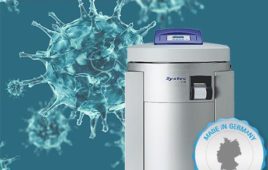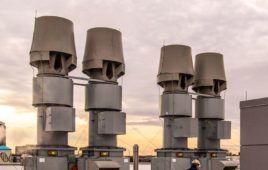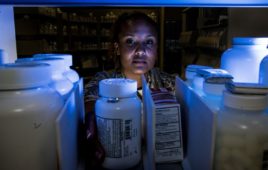Since launching its program to develop global cleanroom standards in 1990, the International Organization of Standards (ISO) has published ten ISO 14644 standards under the auspices of Technical Committee (ISO/TC) 209, Cleanrooms and associated controlled environments. The voting members of ISO/TC 209 represent 22 nations. The ISO 14644 cleanroom standards established airborne particulate cleanliness classes for particle sizes ranging from 0.1 µm to 5 µm.
Nine of these international standards have also been approved by the American National Standards Institute (ANSI) as American national standards. The Institute of Environmental Sciences and Technology (IEST) is Secretariat of ISO/TC 209 and Administrator of the ANSI-accredited US Technical Advisory Group (TAG) to ISO/TC 209.
IEST also develops recommended practices (RPs) for the nanotechnology; contamination control; design, test, and evaluation; and product reliability industries. For over 60 years, this society has tapped the voluntary commitment of industry professionals to develop these documents based on their industries’ best practices.
Together, these non-profit organizations contribute a vast amount of knowledge and resources to the cleanroom and controlled environments industries. This article will provide an overview and summarize the key points of the full array of contamination control guidance documents produced by IEST and ISO and presented at ESTECH, the annual technical meeting of IEST being held May 13-16, 2014, at the Grand Hyatt Hotel in San Antonio, Texas.
Airborne particulate cleanliness
The first two standards published in the ISO 14644 series were Cleanrooms and associated controlled environments – Part 1: Classification of air cleanliness (1999) and Part 2: Testing and monitoring to prove continued compliance with ISO 14644-1 (2000). These standards, together considered the cornerstone of the ISO cleanroom series, are being updated, and proposed revisions were issued in December 2010 as Draft International Standards (DIS). One of the major changes concerns a new principle for selection of cleanroom sample locations. Currently, both the original standards and the DIS versions may be used as trade reference per agreement between customers and suppliers.
Several IEST RPs enable end users to meet the requirements of ISO 14644-1 and -2, including:
• IEST-RP-CC001: HEPA and ULPA Filters—For use as a reference prior to selecting air filters for the cleanroom.
• IEST-RP-CC002: Unidirectional Flow Clean-Air Devices—Reviews products and systems available for directing air flow in the cleanroom.
• IEST-RP-CC006: Testing Cleanrooms—Reviews how to perform particle testing and associated testing to achieve the desired ISO cleanliness classifications.
• IEST-RP-CC007: Testing ULPA Filters—For use to evaluate ULPA filters used in the cleanroom.
• IEST-RP-CC019: Qualifications for Organizations Engaged in the Testing and Certification of Cleanrooms and Clean-Air Devices—Provides guidelines for evaluating and selecting subcontractors to test and certify cleanrooms.
• IEST-RP-CC021: Testing HEPA and ULPA Filter Media—Describes test methods for physical and filtration properties, and includes a table on filter-testing frequency.
Additionally, IEST publishes four technical guides to assist cleanroom operators testing for particles:
• IEST-G-CC1001: Counting Airborne Particles for Classification and Monitoring of Cleanrooms and Clean Zones
• IEST-G-CC1002: Determination of the Concentration of Airborne Ultrafine Particles
• IEST-G-CC1003: Measurement of Airborne Macroparticles
• IEST-G-CC1004: Sequential-Sampling Plan for Use in Classification of Particulate Cleanliness of Air in Cleanrooms and Clean Zones
Biocontamination control
ISO/TC 209 published two biocontamination control standards in 2000: ISO 14698-1: General principles and methods, and ISO 14698-2: Evaluation and interpretation of biocontamination data. Associated RPs that assist cleanroom operators in achieving the principles in these ISO standards are:
• IEST-RP-CC013: Calibration Procedures and Guidelines for Selecting Equipment Used in Testing Cleanrooms and Other Controlled Environments
• IEST-RP-CC023: Microorganisms in Cleanrooms
Testing
ISO 14644-3: Test methods specifies metrology and test methods for characterizing the performance of cleanrooms and clean zones. Relatedly, IEST-RP-CC014: Calibration and Characterization of Optical Airborne Particle Counters and IEST-RP-CC034: HEPA and ULPA Filter Leak Tests provide test methods for compliance with ISO 14644-3.
Cleanroom design and construction
ISO 14644-4: Design, construction and start-up provides guidance for cleanroom designers, contractors, purchasers, and suppliers. A useful tool for cleanroom installers is the construction protocol included in IEST-RP-CC012: Considerations in Cleanroom Design, which addresses the design and installation of cleanroom production equipment and includes a table on cleanroom classifications, airflow velocities, and recommended number of air changes per hour. IEST-RP-CC024: Measuring and Reporting Vibration in Microelectronics Facilities provides guidance regarding the special vibration considerations for equipment in the cleanroom. IEST-RP-CC022: Electrostatic Charge in Cleanrooms and Other Controlled Environments addresses design aspects that enable control of static electricity in cleanrooms.
Cleanroom operations
IEST RPs that support the basic requirements outlined in ISO 14644-5: Operations include:
• IEST-RP-CC003: Garment System Considerations for Clean-rooms and Other Controlled Environments is used to select garments to protect both product and personnel from contaminants.
• IEST-RP-CC004: Evaluating Wiping Materials Used in Cleanrooms and Other Controlled Environments is used to evaluate wipers used to clean surfaces of the product and the cleanroom. Wipers should be selected based on their intended usage.
• IEST-RP-CC005: Gloves and Finger Cots Used in Cleanrooms and Other Controlled Environments is used to select gloves to protect both product and personnel from contaminants or hazardous materials. Describes methods to test glove properties and provides guidance on donning and doffing the glove.
• IEST-RP-CC018: Cleanroom Housekeeping – Operating and Monitoring Procedures provides practical information regarding cleaning techniques, equipment, cleaning compounds, housekeeping checklists, and methods for auditing housekeeping.
• IEST-RP-CC020: Substrates and Forms for Documentation in Cleanrooms provides methods for assessing the cleanliness of items such as paper, labels, forms, and similar materials.
• IEST-RP-CC026: Cleanroom Operations provides guidance to maintain the integrity of the cleanroom during operation.
• IEST-RP-CC027: Personnel Practices and Procedures in Cleanrooms and Controlled Environments reviews behavior requirements for personnel working inside the cleanroom. Includes gowning requirements.
• IEST-RP-CC032: Flexible Packaging Materials for Use in Cleanrooms and Other Controlled Environments provides guidance for the selection of packaging to protect product integrity.
Minienvironments and Enclosures
ISO 14644-7: Separative devices addresses enclosures such as barrier isolator systems, clean air hoods, gloveboxes, and minienvironments. IEST-RP-CC028: Minienvironments provides guidance specifically for minienvironments in cleanrooms.
Molecular contamination
The primary concern for any product produced in a cleanroom environment is the potential impact of airborne molecular contamination (AMC) on the product. ISO 14644-8: Classification of airborne molecular contamination addresses airborne concentrations of specific chemical substances and provides a protocol to include test methods, analysis, and time weighted factors within the specification for classification.
The guideline IEST-G-CC035: Design Considerations for AMC Filtration Systems in Cleanrooms covers HVAC system design, filter selection, and the materials used to build the cleanroom. IEST-RP-CC016: The Rate of Deposition of Nonvolatile Residue in Cleanrooms is a reference for cleanroom certification and monitoring of nonvolatile residue. IEST-RP-CC031: Method for Characterizing Outgassed Organic Compounds from Cleanroom Materials and Components provides guidance for the selection of materials to assure cleanroom compatibility.
Surface cleanliness
ISO 14644-9: Classification of surface cleanliness by particle concentration describes the classification of particle contamination levels on solid surfaces and recommends testing and measuring methods. ISO 14644-10: Classification of surface cleanliness by chemical concentration defines the classification system for cleanliness of surfaces in cleanrooms with regard to the presence of chemical compounds or elements (including molecules, ions, atoms, and particles).
IEST-STD-1246: Product Cleanliness Levels – Applications, Requirements, and Determination, a standard for testing of surfaces for contaminants, provides guidance for the selection of the test methods to demonstrate the cleanliness level required. IEST also has an RP under development on this topic. IEST-RP-CC043: Surface Molecular Contamination will describe the types of surface molecular contamination (SMC) that may affect critical surfaces and processes, sources of SMC, and measurement and control methods.
Nanotechnology
ISO/TC 209 also established a nanotechnology WG to develop contamination control standards for industries involving materials and devices on the nanoscale. This WG is convened by the U.S. under the leadership of IEST. The first document will be written to help those in the field of nanotechnology apply the existing series of ISO/TC 209 documents. Future standards are proposed to include classification of air cleanliness and metrology; design, construction and start-up; operations, and nanobiotechnology. Another ISO technical committee, ISO/TC 229 Nanotechnologies, is addressing all aspects of this emerging discipline. IEST represents the environmental sciences as a voting member of the ANSI-accredited US TAG to ISO/TC 229.
IEST WGs are developing a series of RPs addressing nanotechnology topics. IEST-RP-NANO200: Planning of Nanoscale Science and Technology Facilities: Guidelines for Design, Construction, and Start-up, was published in 2013. Also under development is IEST-RP-NANO205: Nanotechnology Safety: Applying Prevention through Design Principles to Nanotechnology Facilities.
Also on the docket
IEST recently published IEST-RP-CC046: Controlled Environments (Aerospace, Non-cleanroom) and IEST-RP-CC042: Liquid-borne Particle Counting.
Several RPs are under development and revision. Interested professionals are invited to participate in the Working Groups at ESTECH. Titles under development or revision include:
• Contamination Control in Regulated Industries
• Contamination Control in Compounding Cleanrooms
• Vibration and Acoustics in Nanotechnology
• Testing Aerosol-Nanomaterial Containment Devices
• CC002: Unidirectional Flow Clean-Air Devices
• CC003: Garment Considerations for Cleanrooms and Other Controlled Environments
• CC004: Evaluating Wiping Materials Used in Cleanrooms and Other Controlled Environments
• CC006: Testing Cleanrooms
• CC012: Considerations in Cleanroom Design
• CC019: Qualifications for Organizations Engaged in the Testing and Certification of Cleanrooms and Clean-Air Devices
• CC020: Substrates and Forms for Documentation in Cleanrooms
• CC021: Testing HEPA and ULPA Filter Media
• CC023: Microorganisms in Cleanrooms
• CC025: Evaluation of Swabs Used in Cleanrooms
• CC034: HEPA and ULPA Filter Leak Tests
• CC041: Recovery from Disruption to Cleanrooms and Other Controlled Environments
• CC044: Vacuum Cleaners and Systems for Cleanrooms and Other Controlled Environments
• CC046: Contamination Control in Controlled Environments
• CC047: Cleanroom Lighting
• CC205: Nanotechnology Safety: Applying Prevention through Design Principles to Nanotechnology Facilities
• CC902: MIL-HDBK-406: Contamination Control Technology: Cleaning Materials for Precision Pre-Cleaning and Use in Cleanrooms and Clean Work Stations; MIL-HDBK-407: Contamination Control Technology: Precision Cleaning Methods and Procedures.
Details about each of the standards and RPs discussed in this article, along with information on how to participate in Working Groups, can be found in the Standards and RPs area of the IEST website at www.iest.org.
The documents, including both the original and revised versions of ISO 14644 Parts 1 and 2, are available through the IEST Bookstore.
Standards Training
Contamination control courses offered at ESTECH will explain practical applications of various standards and RPs. Two courses will focus on using documents to comply with USP Chapter 797, Pharmaceutical Compounding – Sterile Preparations:
• Cleanroom Operations for USP 797 will explain what is required to reduce the risk of microbial contamination, with reference to IEST-RP-CC018.4: Cleanroom Housekeeping: Operating and Monitoring Procedures and IEST-RP-CC026: Cleanroom Operations.
• Advanced Design of USP-797 Compounding Pharmacies will discuss how principles of IEST-RP-CC012.2: Considerations in Cleanroom Design form the basis for the design and environmental control of a sterile facility.
The popular ISO Certificate Series will provide insights on the ISO cleanroom standards and pending revisions. The three courses in the series may also be taken individually:
• Understanding the ISO Series provides an overview of the ISO 14644 series, ISO 14644-2 specifications for testing and monitoring, and possible major changes to future documents.
• Testing to Determine the Classification of Air Cleanliness explains the ins-and-outs of particle count performance in cleanrooms and clean zones in relation to the requirements in ISO 14644-1.
• Application of ISO 14644-3 discusses the practical application of the series that a certification contractor would use to certify a clean space, including an open discussion on how best to implement these standards.
Those interested in attending all of these courses can register for the ESTECH Education Passport and save on four full days of training.
Jan Eudy is a Cleanroom/Contamination Control Consultant as well as a Fellow and Past President, Institute of Environmental Sciences and Technology. She can be reached at [email protected].
This article appeared in the May 2014 issue of Controlled Environments.



